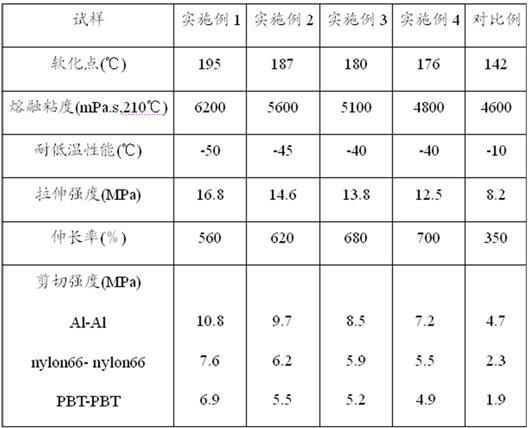Dimer acid type polyamide hot melt adhesive and preparation method thereof
A technology of polyamide hot melt adhesive and dimer acid type, which is applied in the direction of adhesives, etc., can solve the problems of poor low temperature resistance, high water absorption, low softening point, etc., and achieve high softening point, low high temperature melt viscosity, and good adhesion The effect of high reliability
- Summary
- Abstract
- Description
- Claims
- Application Information
AI Technical Summary
Problems solved by technology
Method used
Image
Examples
Embodiment 1
[0028] Add C to a 1000ml reaction flask equipped with a thermometer, mechanical stirrer, condenser and nitrogen 18340.8g of dimerized linoleic acid, 80.8g of sebacic acid, 166.5g of N-alkyl propylenediamine, 4.0g of stearic acid, 0.5g of hypophosphorous acid, and put the mixed N-alkyl into the 100ml constant pressure dropper Mixture of 166.5g of propylenediamine and 8.8g of butanediamine, pass nitrogen gas to prevent oxidation, heat up while stirring, when the temperature in the reaction bottle reaches 130°C, start to add N-alkylpropylenediamine and butylenediamine dropwise to mix Liquid, the temperature is controlled at 130°C. After the dropwise addition, the temperature starts to rise slowly to about 240°C. During the heating process, water distills out. When the reaction temperature reaches 240°C, use a vacuum pump to vacuumize and depressurize. The vacuum degree is <100Pa. Keep the stirring rate at a certain value. After 3 hours of reaction, the vacuum is released to end t...
Embodiment 2
[0030] Add C to a 1000ml reaction flask equipped with a thermometer, mechanical stirrer, condenser and nitrogen 18 397.6g of dimerized oleic acid, 56.4g of azelaic acid, 4.3g of piperazine, 1.0g of propionic acid, 0.5g of phosphorous acid, and 138.8g of mixed N-alkylpropylenediamine and 12g of ethylenediamine, feed nitrogen to prevent oxidation, heat up while stirring, when the temperature in the reaction bottle reaches 130°C, start to drop the mixed solution of N-alkylpropylenediamine and ethylenediamine, and control the temperature at 130°C ℃, after the dropwise addition, start to slowly heat up to about 240°C, water distills out during the heating process, when the reaction temperature reaches 240°C, use a vacuum pump to vacuumize and depressurize, the vacuum degree is <100Pa, keep the stirring rate at a certain After 3 hours of reaction, the vacuum was released to end the reaction, and the molten polyamide resin was poured on a perchlorethylene plate to obtain a yellow str...
Embodiment 3
[0032] Add C to a 1000ml reaction flask equipped with a thermometer, mechanical stirrer, condenser and nitrogen 18 454.4g of dimerized oleic acid, 40.4g of sebacic acid, 7.1g of cyclohexyl-p-dimethylamine, 4.0g of stearic acid, 0.5g of hypophosphorous acid, and put the mixed N-alkylpropane into a 1000ml constant pressure dropper Mixed solution of 120.3g of diamine and 18g of ethylenediamine, feed nitrogen to prevent oxidation, stir and heat up at the same time, when the temperature in the reaction bottle reaches 130°C, start to add N-alkylpropylenediamine and ethylenediamine dropwise, the temperature is controlled At 130°C, after the dropwise addition, start to slowly heat up to about 240°C, water distills out during the heating process, when the reaction temperature reaches 240°C, use a vacuum pump to evacuate and depressurize, the vacuum degree is <100Pa, keep the stirring rate at After a certain value, after 3 hours of reaction, the vacuum was released to end the reaction, ...
PUM
| Property | Measurement | Unit |
|---|---|---|
| softening point | aaaaa | aaaaa |
Abstract
Description
Claims
Application Information
 Login to View More
Login to View More - R&D
- Intellectual Property
- Life Sciences
- Materials
- Tech Scout
- Unparalleled Data Quality
- Higher Quality Content
- 60% Fewer Hallucinations
Browse by: Latest US Patents, China's latest patents, Technical Efficacy Thesaurus, Application Domain, Technology Topic, Popular Technical Reports.
© 2025 PatSnap. All rights reserved.Legal|Privacy policy|Modern Slavery Act Transparency Statement|Sitemap|About US| Contact US: help@patsnap.com


